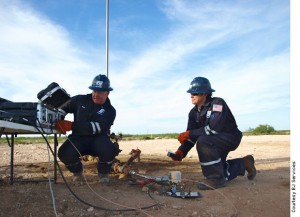简介:BJ服务公司发布一项新型增产技术,针对产能不足和堵塞井,利用电磁波频率来提升产能。EcoWave 处理技术以低功率方式向井内传输高频无线电波和微波,来影响井下流体分子键,从而帮助消除或者抑制有机沉淀,提升油藏湿润度。
BJ Services Company has launched a new stimulation technology that promises production increases in underproducing and plugged wells using a combination of electromagnetic wave frequencies transmitted into the wellbore. The company’s patent-pending EcoWave treatment service transmits high-frequency radio waves and microwaves downhole at low power to affect downhole molecular bonding, thus helping to remove and inhibit organic deposition and improve reservoir wettability.
“EcoWave technology is unlike any stimulation treatment in its simplicity,” said Fred Toney, vice president for Chemical Services, BJ Services. “It requires no chemicals, no pumping equipment, and no large crews on location. It relies almost entirely on electromagnetic waves to alter downhole fluid characteristics in flowing and pump-assisted wells. The economic benefits can be significant because lifting costs are reduced, while increasing hydrocarbon production.”
The EcoWave system employs a combination of very-high frequency and super-high frequency radio frequencies to elicit changes in the fluid characteristics of wax-laden crudes, which have a tendency to form waxy deposits in the tubing of a producing well.

The system includes a frequency generator/amplifier, a portable power source, and an antenna. The antenna is deployed inside the tubing or the annulus of the well through the wellhead. BJ Services theorizes that as electromagnetic energy is transmitted at low power levels through the antenna and into the wellbore, the proper combination of wave frequencies alters the proton and electron spin cycles of deposits. This has the effect of altering the degree of hydrogen bonding and charge induction that causes aggregation of wax particles, thus inhibiting agglomeration and simplifying the removal of paraffin and related organic deposits from the wellbore.
In addition to the economic benefit of increased production, the treatment reportedly provides environmental and safety advantages over conventional treatment solutions. For example, the EcoWave service removes the need for batch or continuous chemical treatments and hot oil and water applications to remediate wells. Such conventional treatments run the risk of producing interactions with incompatible formation fluids which may be damaging to the reservoir.

The company has successfully completed more than 60 applications of the EcoWave treatment in the US. Treatment times range from 30 minutes to two hours, providing production increases that are sustained at elevated levels for several days and up to three months after a single treatment. Results have demonstrated near-wellbore deposit removal and production increases from 20 to greater than 120% compared with chemically treated wells.
One operator in northeastern Utah trialed the EcoWave system on 11 wells with significant paraffin deposition challenges. Downhole deposits on one of the wells caused the pump to become stuck in the wellbore, shutting down production entirely. After a two-hour EcoWave service treatment, the operator was able to regain control of the pump and continue production from the well.
In another field trial, BJ Services crews treated two wells near Hobbs, New Mexico with EcoWave technology to replace traditional hot oil treatments. Oil production initially increased by 57 and 126% in the two wells, respectively, and then stabilized for several months. By comparison, a chemically treated offset well in the same field recorded a slight increase to mostly steady production.

